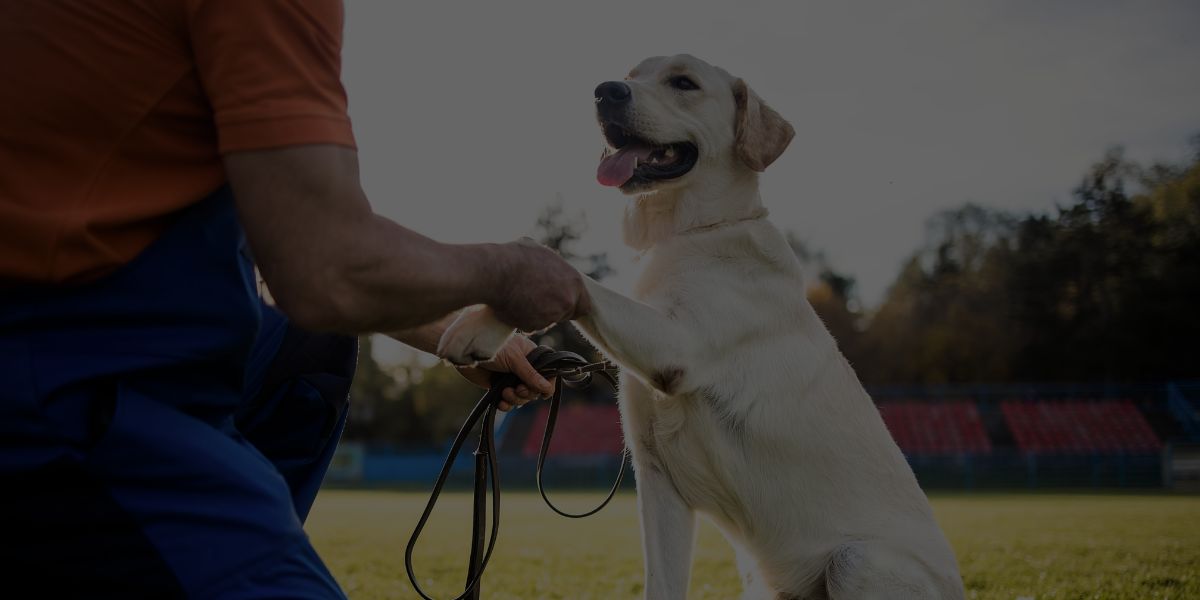Dog Training Methods: Key Points
- Positive reinforcement is the gold standard.
- Dogs learn through associations and consequences.
- Humane, science-backed methods build trust.
- Punishment-based methods risk fear and harm.
- Trainers and owners must choose approaches carefully.
Introduction
Dog training shapes how dogs live, learn, and connect with people. For pet parents, it means a well-behaved, confident companion. For aspiring or professional trainers, it’s about applying proven methods to solve behavior problems and strengthen the bond between clients and their dogs.
The challenge? There are many types of dog training methods, and not all are equally effective or humane. Understanding the differences helps you choose approaches that are science-backed, practical, and built on trust.
Keep reading to explore 12 dog training methods explained, and learn which ones work best for modern dogs and trainers.
Meet QC Pet Studies Graduate & Professional Dog Trainer, Karl Anthony

Karl Anthony’s passion for dog training began 3.5 years ago with his own dog, Piper. Reactive and challenging, Piper pushed Karl to find ways to create peace at home and on walks. What started as problem-solving grew into a calling. In winter 2024, Karl graduated from QC Pet Studies’ Dog Training Course, earning his designation as an International Dog Training Professional™ (IDTP™).
With more than 25 years of experience coaching and mentoring people, Karl now applies those same principles to canine training. He focuses on helping dogs with “big emotions,” especially reactive working breeds, while guiding puppy owners in building strong foundations. His approach mirrors fitness coaching: clear goals, broken into simple steps, leading to steady progress. Watching both dogs and their owners gain confidence—and seeing reactive dogs transform—is what inspires his work.
After certification, Karl expanded his business, FireTeam K9, from helping friends into offering one-on-one sessions, group classes, and even online coaching. A nurse and military veteran, he named his business after the trusted “fire team partners” who always had your back. For Karl, Piper is that partner, and through FireTeam K9, he helps families build the same kind of trust and teamwork with their own dogs.
Training is more than teaching a dog to sit or stay. It’s about creating safety, improving communication, and setting dogs up for success at home and in public. For professionals, it also means giving clients the tools they need to live harmoniously with their dogs.
Here are some of the key benefits of effective training:
- Safety: Reliable recall and leash manners prevent accidents and keep dogs out of harm’s way.
- Freedom: Trained dogs can enjoy more activities—like off-leash walks, trips to public spaces, and time with family and friends.
- Bonding: Training builds trust and strengthens the relationship between dogs and people.
- Confidence: Clear communication reduces stress and helps dogs feel secure in new situations.
- Problem prevention: Early training prevents unwanted behaviors such as jumping, pulling, or destructive chewing.
- Professional impact: For trainers, using proven methods builds credibility, improves client satisfaction, and supports long-term results.
Good training benefits everyone involved: the dog, the owner, and the trainer guiding the process.
Understanding How Dogs Learn: The Science Behind Behavior
To choose the best training methods, you first need to understand how dogs actually learn. Whether you’re teaching your own pet or working with client dogs, knowing the science behind behavior makes training more effective and humane.
Classical Conditioning (Learning Through Associations)
Classical conditioning happens when a dog connects one event with another. The most famous example is Pavlov’s dogs, who learned that the sound of a bell meant food was coming.
In everyday life, dogs form associations like these:
- Hearing the food bowl means dinner is ready.
- Seeing the leash means a walk is about to happen.
- The doorbell rings, and they expect a visitor.
These learned signals shape how dogs respond to their environment.
Operant Conditioning (Learning Through Consequences)
Operant conditioning is about cause and effect. Dogs repeat behaviors that bring good outcomes and avoid behaviors that bring unpleasant ones. This idea was first studied in depth by psychologist B.F. Skinner in the 1930s, who showed how animals learn through rewards and consequences.
There are four parts to operant conditioning:
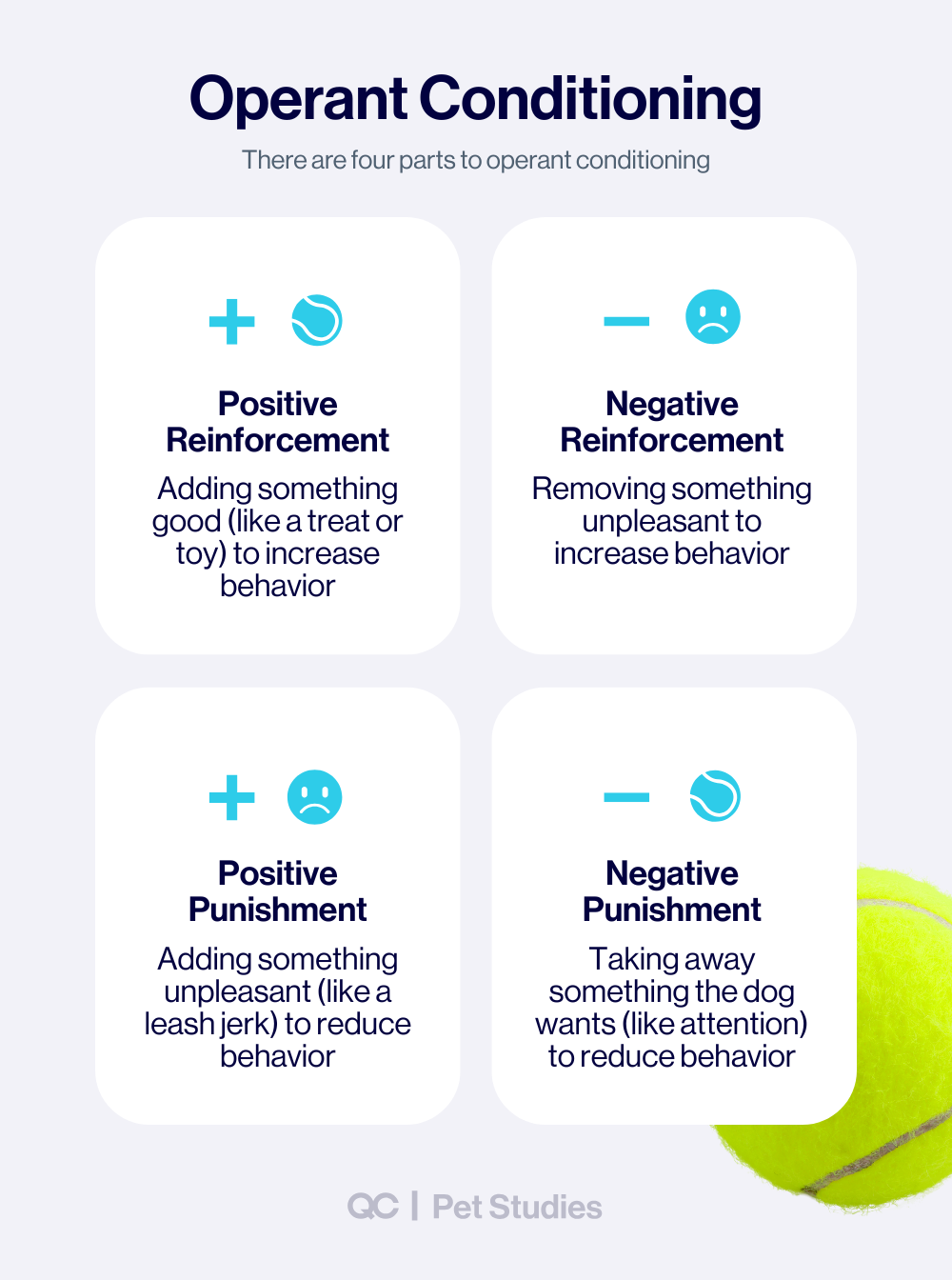
While all four exist, modern trainers agree that positive reinforcement is the most effective, ethical, and sustainable approach. This is because it builds trust instead of fear and leads to better long-term results.
12 Dog Training Methods Explained
While most training styles fall into one of three main approaches (which we’ll cover shortly), trainers tend to use specific methods within those categories. Some are science-backed and widely recommended. Others are argued to be controversial and/or outdated.
By understanding all 12 dog training methods, you’ll be able to make informed choices, whether you’re training your own dog or guiding clients.
Method #1: Positive Reinforcement Training
This dog training method rewards desired behavior with treats, toys, or praise. Dogs quickly learn which actions bring good outcomes. In turn, they’re then motivated to repeat that behavior again because they now connect it to a good thing.
BEST FOR: Puppies, rescues, and any dog learning new skills.
Method #2: Clicker Training
A type of positive reinforcement, clicker training uses a handheld device that makes a distinct sound (“click”) to mark the exact moment the dog does the right thing. The click is always followed by a reward.
BEST FOR: Precise behaviors like agility, tricks, or advanced obedience.
Method #3: Science-Based Training
Science-based training is less about a single technique and more about a philosophy of using the most current research in animal behavior, psychology, and learning theory. Trainers who follow this approach draw on studies from experts like B.F. Skinner, Karen Pryor, and modern veterinary behaviorists. They blend proven strategies—such as classical conditioning, operant conditioning, and positive reinforcement—into an adaptable system.
What makes this different from other methods is that it isn’t tied to tradition or personal belief. A science-based trainer continually reviews evidence, asks whether a technique is truly effective, and adjusts based on what research shows is humane and sustainable. This means avoiding outdated practices like dominance theory or harsh punishment, even if those methods “seem” to work in the short term.
BEST FOR: Trainers who want a modern, adaptable framework grounded in research. Ideal for professionals working with a wide variety of clients and dogs.
💡 Trainer Insight: Any humane dog training method that’s supported by science, especially positive reinforcement, is what reputable professionals should practice and promote.
Method #4: Relationship-Based Training
This method focuses on the bond between human and dog. Training is customized to the individual dog, with emphasis on trust, communication, and meeting the dog’s needs before expecting results.
BEST FOR: Building stronger partnerships and addressing emotional needs.
Method #5: Model-Rival / Mirror Training
Dogs learn by observation. In this method, the trainer, handler, or another dog acts as the model and demonstrates the desired behavior/action. The dog (as the learner) then copies the behavior they see, especially when they see the model being rewarded.
BEST FOR: Social dogs that pay attention to people or other dogs.
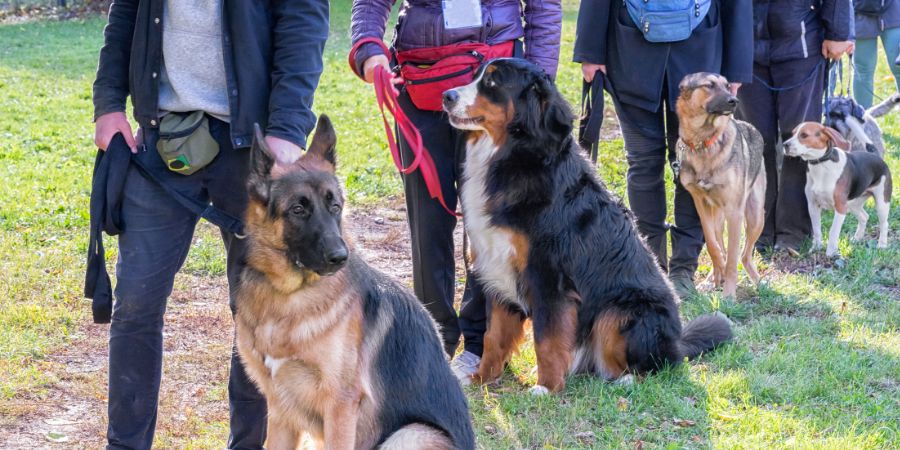
Method #6: Classical Conditioning in Practice
Based on Pavlov’s research, this method pairs events so the dog learns associations. For example: pairing nail trims with treats, or thunder with a safe retreat and calm praise.
Unlike positive reinforcement, which teaches dogs to repeat specific behaviors to earn rewards, classical conditioning changes the dog’s emotional response to a situation. It’s less about teaching a command and more about reshaping how the dog feels, turning something scary or neutral into something positive.
BEST FOR: Reducing fear, changing emotional responses, and creating positive associations.
Method #7: Operant Conditioning in Practice
A practical application of Skinner’s framework, using rewards to increase desired behaviors and carefully managing consequences for unwanted ones. Trainers may use “shaping” (rewarding small steps) or “capturing” (rewarding natural behaviors).
This is also different from positive reinforcement, which focuses only on adding rewards to encourage behavior. Operant conditioning, on the other hand, includes all four quadrants: reinforcement and punishment, both positive and negative. Positive reinforcement is just one part of this larger framework. However, it’s the quadrant modern trainers recommend most often because it’s effective and humane.
BEST FOR: Teaching both basic obedience and complex behaviors (though the use of punishment carries risks).
Method #8: Balanced Training (Reward + Correction)
Balanced training combines reinforcement with corrections, such as leash pops or verbal reprimands. While some trainers lean heavily toward rewards, others rely more on aversives.
BEST FOR: Trainers who use corrections sparingly and responsibly (though it still carries risks if misapplied).
Method #9: Correction-Based / Traditional Training
This approach relies almost entirely on punishment, assuming dogs misbehave out of dominance. It often uses harsh tools like choke chains.
BEST FOR: Rarely recommended; may suppress behavior but can damage trust and cause fear.
Method #10: LIMA (Least Intrusive, Minimally Aversive)
This philosophy encourages starting with the gentlest methods first. More intrusive or aversive techniques are used only when necessary. The LIMA method allows flexibility while keeping the dog’s welfare central.
BEST FOR: Trainers who primarily want a structured, humane framework to guide decisions, but who are still open to aversive action if they deem it necessary.
Method #11: Electronic Collar Training (E-Collar)
Dogs wear a collar that delivers a vibration or shock as correction. While some argue it’s useful for long-distance work, misuse can cause pain, fear, and behavior fallout.
BEST FOR: Specialized cases like off-leash hunting or safety recalls—but only under expert supervision.
Method #12: Puppy-Specific Training Approaches
Puppies need gentle, reward-based training to set foundations for life. Early focus includes socialization, bite inhibition, crate training, and potty training. Harsh corrections are never appropriate for young pups.
What makes this its own separate training method is that it’s not just about teaching behaviors with a specific kind of reinforcement—it’s about applying training in ways that are developmentally appropriate for a growing puppy. For example, puppies require shorter sessions, early exposure to new experiences, and extra patience while they mature.
BEST FOR: New puppy owners and trainers guiding early development.
Dog Training Methods: Mistakes To Avoid
That said, even the best method can fail if used incorrectly. So, here are a few pitfalls to watch out for:
- Poor timing: Rewarding too late means the dog may not connect the reward to the right behavior.
- Over-reliance on treats: Food is powerful, but mixing in toys, praise, or life rewards (like play) keeps motivation strong.
- Inconsistency: If family members or clients use different cues, the dog becomes confused.
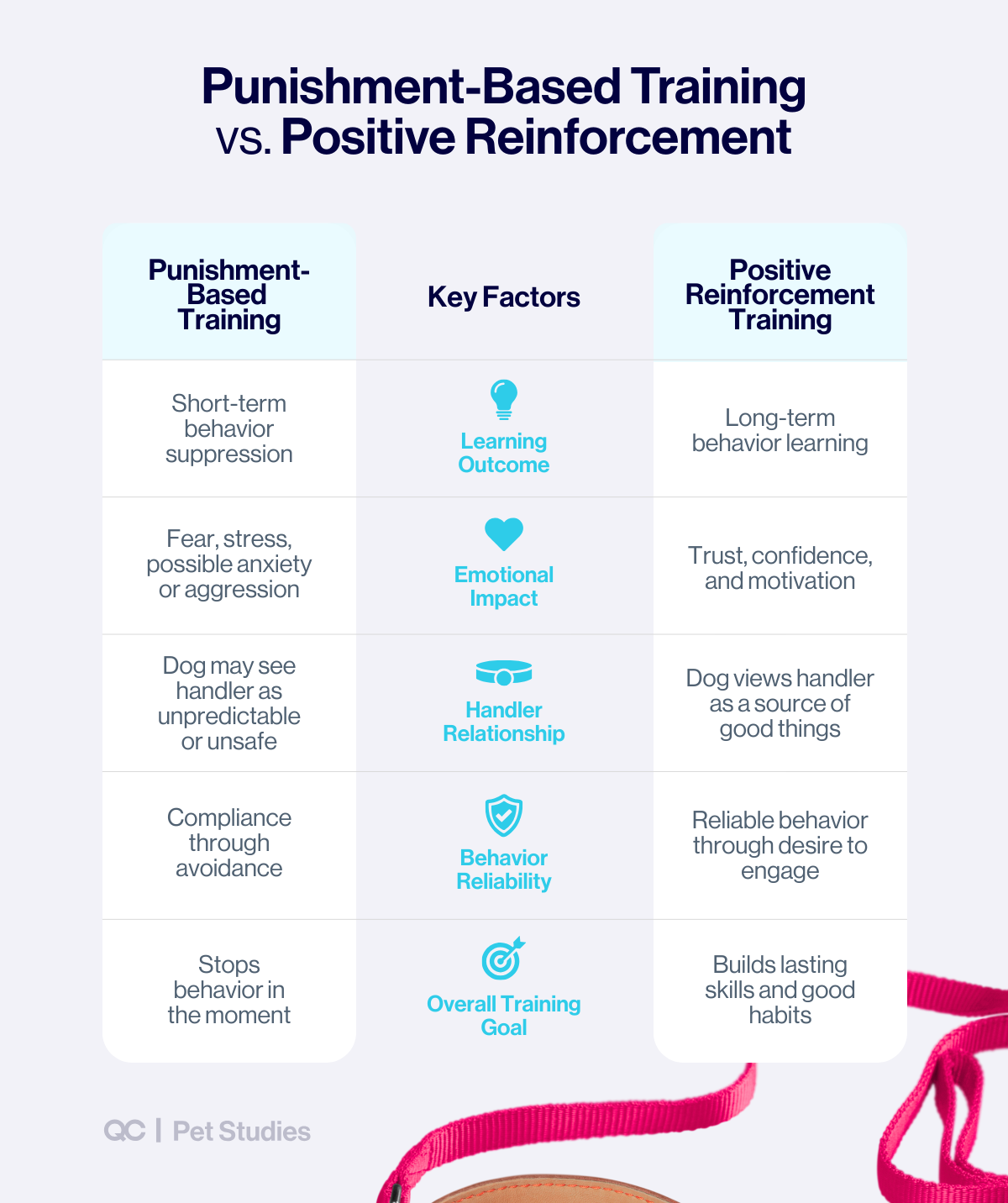
Dog Training Methods and Philosophies: Understanding the Differences
Dog training isn’t one-size-fits-all. Over the years, different methods and philosophies have developed, each with its own tools, goals, and way of looking at dog behavior.
For dog owners, this can be confusing. For aspiring or professional trainers, understanding these differences is key to guiding clients toward humane, effective choices.
At the broadest level, training methods fall into distinct categories or “camps.” These camps are shaped by how trainers believe dogs learn, the role of rewards and corrections, and the overall philosophy behind training. While some trainers stick firmly to one camp, many use techniques that overlap.
By learning the differences, you can:
- Recognize what each method emphasizes.
- Understand the tools and techniques commonly used.
- Identify which approaches are science-backed and which rely on outdated ideas.
- Make informed choices for your own dog, or recommend the right path to your clients.
Teach Dog Training Methods Professionally
Get fully trained + certified in as little as 3 months, right from home!
The Three Main Dog Training Approaches Explained
Next, let’s break down the three main approaches most training styles fall under.
Most training philosophies can be grouped into three major approaches/camps. Each camp looks at behavior differently, uses different tools, and sets different goals. Understanding these three approaches is the foundation for evaluating any dog training method.
1 – Positive Reinforcement (Force-Free Training Explained)
This approach focuses on rewarding the behaviors you want to see. Dogs repeat actions that bring them something good—like treats, toys, or praise. Unwanted behaviors are managed or redirected, not punished.
Pros:
- Builds trust and strengthens the bond between dog and human.
- Reduces stress, fear, and aggression.
- Works for all ages and breeds, including puppies and rescues.
- Backed by decades of scientific research.
Cons:
- Requires consistency and patience from handlers.
- Owners may need coaching to use timing and reward delivery correctly.
2 – Balanced Training: Combining Rewards and Corrections
Balanced trainers use a mix of positive reinforcement and corrections. For example, a dog may earn treats for good behavior but also receive a leash pop or e-collar stimulus for unwanted behavior.
Pros:
- May deliver faster results for some behaviors.
- Trainers often emphasize individualizing the approach to the dog.
Cons:
- Risk of misuse if punishment is applied too harshly or inconsistently.
- Can harm the relationship between dog and owner if the dog associates corrections with the handler.
- Doesn’t always address the root cause of behaviors like fear or anxiety.
💡 Trainer Insight: While some balanced trainers lean heavily on rewards, others rely too much on corrections. For aspiring trainers, it’s important to recognize this spectrum.
3 – Correction-Based or “Old School” Training Methods
We briefly touched on this earlier when discussing operant conditioning, but essentially, this approach relies primarily on punishment to stop unwanted behavior. It often assumes dogs misbehave to gain dominance over people, so the handler must act as the “alpha.” Tools may include choke chains, prong collars, or harsh verbal and physical corrections.
Pros:
- Can stop behavior quickly in the short term.
- Has been historically popular and still used by some trainers.
Cons:
- Based on outdated ideas about dominance and “pack theory.”
- High risk of creating fear, anxiety, or aggression.
- Damages the bond between dog and owner.
- Not supported by modern science.
💡 Trainer Insight: These methods are falling out of favor, but they still appear in media and online. Aspiring trainers should know how to recognize them—and why they are not recommended.

6 Proven Dog Training Tips for Everyday Success
Whether you’re training your own dog or coaching clients, a few core principles can make training smoother and more effective. These habits keep sessions fun, productive, and stress-free for both dogs and people.
Tip #1: Keep Training Sessions Short and Engaging
Dogs, like people, have a limited attention span. Short lessons of 5–10 minutes, repeated a few times a day, are far more effective than one long session. This prevents frustration and helps the dog stay motivated. Always try to end on a success—even something as simple as a “sit”—so the dog finishes feeling confident.
💡 Trainer Insight: For clients with busy schedules, remind them that even a few minutes during a coffee break or before dinner can make a big difference.
Tip #2: Start in Calm, Low-Distraction Environments
Begin teaching new skills in a quiet, familiar place. For instance, a dog learning “down” for the first time won’t succeed in a busy park. Once the dog masters the behavior indoors, slowly add distractions: background noise, other people, or different environments.
💡 Trainer Insight: Gradual exposure helps prevent setbacks. Encourage clients to increase distractions only when their dog succeeds consistently at the current level.
Tip #3: Use High-Value Rewards Consistently
Rewards drive behavior. For some dogs, that means tiny pieces of chicken or cheese. For others, it could be a favorite squeaky toy or a chance to play tug. Either way, the higher the value of the reward, the more eager the dog will be to repeat the behavior.
💡 Trainer Insight: Teach owners to experiment with different rewards and rotate them to keep things exciting. What works in the living room may not be motivating enough outside with squirrels and smells competing for attention.
Tip #4: Be Clear and Consistent Across Handlers
Dogs thrive on consistency. This means ensuring that the same word is always used for a given command. For example, if one family member uses “down” and another says “lie,” the dog may get confused and frustrated.
Agreeing on cues, tone, and timing ensures the dog understands what’s being asked.
💡 Trainer Insight: Provide clients with a written list of chosen commands. This helps every family member stay on the same page and reduces mixed signals.
Tip #5: Always End on a Positive Note
Even if a training session is challenging, wrap it up with something the dog knows well. This could be a simple “sit” or “touch.” Pair it with praise, a treat, or play. Ending positively boosts the dog’s confidence and makes them look forward to the next session.
💡 Trainer Insight: Ending on a success is just as important for the human as it is for the dog. It leaves both feeling encouraged instead of frustrated.
Tip #6: Keep Training Fun and Relationship-Focused
Always keep in mind that dogs aren’t robots. Meaning, training should feel like a game, not a chore. Smiling, using a happy voice, and including play as part of training helps the dog stay engaged and strengthens the bond between dog and handler.
💡 Trainer Insight: Remind clients that every interaction with their dog is a training opportunity. Reward calm behavior at home, praise polite greetings on walks, and celebrate progress often.
How to Choose the Right Dog Trainer or Behavior Specialist
Not all trainers use the same methods, and not all are equally qualified. For dog owners, finding the right trainer means setting your dog up for success. For aspiring or professional trainers, knowing what clients look for can help you stand out in a competitive field.
When evaluating a trainer or behavior consultant, keep these factors in mind:
Look for Credentials and Education
A trustworthy trainer should have professional training and certification, not just years of “experience.” Credentials show they’ve studied canine behavior and are committed to ethical standards.
Ask About Training Methods
Always ask: “What happens if my dog gets it wrong?” The answer reveals a lot! Trainers who focus on positive reinforcement will talk about managing, redirecting, or rewarding alternative behaviors. On the other hand, trainers who rely on punishment may mention prong collars, leash jerks, or shock collars.
Check for Transparency
A good trainer explains their methods clearly and welcomes questions. If a trainer avoids specifics or makes guarantees like “I’ll fix your dog in one session,” that’s a red flag!
Evaluate Experience and Specialties
Some trainers specialize in puppy training, while others focus on aggression, fear, or sports. Choose someone whose background matches your needs. (And if you’re a professional trainer, make sure to highlight your niche when marketing your services.)
Trust Your Gut
Both you and the dog should feel comfortable. A good trainer treats dogs with respect and shows patience. If something feels off, it’s okay to say that it simply isn’t the right fit.
If you’re the professional trainer, also remember that demonstrating science-backed, humane methods earns trust and helps you build a reputation that attracts clients who want the very best for their dogs.
And If You’re The Dog Trainer?
Here’s what Karl has to say:
“What helped me land my very first clients was a combination of things, but the most important were volunteering and word-of-mouth. I offered pro bono group and private sessions to friends and family, in exchange for testimonials or referrals. In addition, I also volunteered with a K9 search and rescue team, which allowed me to develop my skills with high-drive working breed dogs. I didn’t get paid, but the experience and the resulting testimonials and referrals were priceless.
My advice to newly certified trainers about building trust and credibility is to be honest about your scope of practice, and commit to continued learning. NEVER take on a case that’s beyond your comfort or skill level. Instead, have a network of professionals you can refer to.
Most importantly, build trust by listening without judgment. Remember: your clients are coming to you because they’re struggling. As such, you need to be their supportive partner, not their critic. Show them the science, but deliver it with empathy. Do that, and you’ll build a loyal client base!”
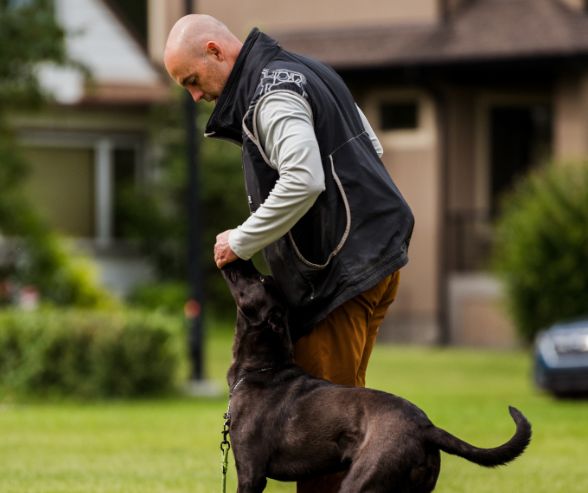
Photo by CKF Photography.
Conclusion: Finding the Right Dog Training Approach
At its heart, dog training is about shaping behavior, building trust, and improving the lives of dogs and people. As we’ve seen, there are many types of dog training methods. Some are rooted in science and compassion, while others are based on outdated ideas of dominance and punishment.
For pet parents, the takeaway is simple: choose humane, positive methods that make your dog feel safe and confident. For aspiring or professional trainers, the responsibility is even greater. Using science-backed approaches not only helps dogs succeed but also builds credibility with clients and sets you apart as a professional.
The gold standard—positive reinforcement—stands out for a reason. It’s humane, effective, and flexible enough for puppies, rescues, and even advanced training scenarios.
Train Dogs the Science-Backed Way with QC Pet Studies
At QC Pet Studies, we’re committed to preparing the next generation of dog trainers to use science-backed, humane methods that focus on positive reinforcement.
Our self-paced, online Dog Training certification course goes beyond the basics, giving you the skills to:
- Understand canine learning theory and behavior.
- Train puppies and adult dogs with confidence.
- Start your very own dog training business.
- Apply positive reinforcement effectively in real-world situations.
- Work with clients and guide them through lasting results.
”QC Pet Studies gave me the science-based foundation every ethical trainer needs. It wasn’t just about learning what to do, but understanding why. That knowledge helped me define my standards and confidently coach clients with a positive-first mindset. For anyone considering QC, I’d say go for it! It’s a solid, credible first step into a career the industry genuinely needs. To get the most from your training, I highly recommend pairing your coursework with additional hands-on experience, such as joining a local dog sport club or SAR team.
Karl AnthonyInternational Dog Training Professional™ (IDTP™)
Ready to become a certified trainer? Explore QC Pet Studies’ Dog Training certification and enroll today!
Dog Training Methods: Frequently Asked Questions (FAQs)
What are the three main methods of training a dog?
The three main approaches are positive reinforcement, balanced training, and correction-based training. Positive reinforcement uses rewards to encourage good behavior. Balanced training mixes rewards with corrections. Correction-based training relies mostly on punishment, which is outdated and not recommended.
What is the most effective dog training method?
Most experts agree that positive reinforcement is the most effective and humane method. It builds trust, strengthens the bond between dog and handler, and creates lasting results without fear or stress.
What are the best dog training methods for puppies?
For puppies, gentle and reward-based approaches work best. Focus on socialization, crate training, bite inhibition, and potty training using positive reinforcement. Harsh corrections should never be used with young dogs.
How do positive reinforcement dog training methods work?
Positive reinforcement works by rewarding the behaviors you want. When a dog sits, comes when called, or walks calmly on leash, they earn something they enjoy—like a treat, toy, or praise. This makes the behavior more likely to happen again.
Are correction-based training methods safe?
Correction-based training often uses tools like choke chains, prong collars, or shock collars. These methods can stop behavior quickly, but they also increase fear, anxiety, and even aggression. For this reason, they are not often recommended. If correction is required, it should only be done by a trained professional.
